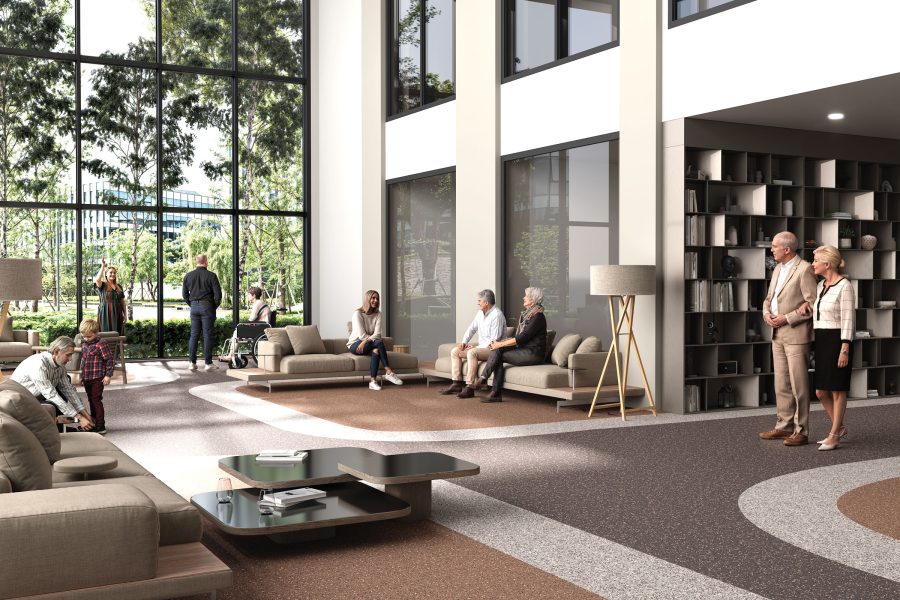Story at a glance:
- Studies show sound pollution can have negative impacts on occupant health.
- Commercial buildings must account for acoustic solutions like flooring that minimize impact and airborne noise.
- Unlike hardwood floors or concrete, commercial rubber flooring solutions offer both soundproof and sound absorption benefits.
Want to design healthy commercial spaces? The secret is sound—or lack thereof.
Studies show that sound pollution—any noise that distracts and disrupts—can trigger the body’s stress response. Chronic noise-induced stress can lead to high blood pressure and heart rate, which increases the risk of cardiovascular disease and stroke. More stress hormones in the body can also lower immunity and prevent sleep, among other health concerns. And it’s not just loud noises causing this stress to our bodies either. Even exposure to chronic low-level noise can have a huge impact on our health.
In commercial buildings noise is unavoidable. Proper acoustics are imperative when it comes to the health of those who work in or occupy these spaces. In offices, for instance, loud sounds and meetings can prohibit essential work from getting done, with potential impact to a business’s bottom line. In educational institutions noise disrupts and detracts from essential learning, stealing focus and attention away from lessons.
It’s all about communication and being able to operate without distraction.
“It’s all about communication and being able to operate without distraction,” says David Good, manufacturing engineer at REGUPOL. “Imagine you have a school building or a classroom right beside a loud, noisy train track. It’s hard to focus with that kind of distraction, and it’s hard to get whatever you’re working on done.”
In health care settings quiet is essential to healing, allowing patients a space to soundly rest and recover for improved health outcomes. “I’ve worked on health care projects where we’ve had to isolate medical machines, like CT scan machines, and other sensitive machinery and equipment where they’re doing laboratory testing and need to get accurate measurements without any sort of vibration, even to scales that people can’t hear or perceive,” Good says.
Clearly, sound matters. And in buildings many elements contribute to the way sound travels throughout a space—the floors we walk chiefly among them.
Why Flooring Matters to Acoustics

Rendering courtesy of REGUPOL
Sound travels through buildings in two ways. Impact noise is what you hear when two objects collide—feet on a floor, weights dropping on the ground. Airborne noise is when sounds like people talking are carried through the air.
When it comes to either of these acoustic strategies, flooring has a huge impact thanks to the sound properties of common materials. Hardwood flooring, for example, doesn’t absorb sound well, making it easy for both impact and airborne sound to carry throughout a space. Meanwhile materials like concrete are inherently good at soundproofing because of its dense and heavy mass—but for the same reasons don’t absorb sound well enough to prevent harsh impact noise.
In commercial buildings noise mitigation comes down to specifying materials that both soundproof and absorb sound. Like concrete, soundproofing materials are typically denser and heavier and are integrated within or under surfaces to add mass to the flooring, decouple flooring surfaces, or dampen vibration between surfaces.
“There are four main components: absorption, mass, decoupling, and damping,” Good says. “You need that mass component to effectively mitigate any sort of vibration. You can think of decoupling as separating two different materials, either with an elastic material or an air gap, almost like a spring in between two rigid materials. That’s kind of how the underlayment works. Lastly, damping removes the stress on materials from sound vibrations.”
On the other hand, materials that absorb sound tend to be softer and lighter, similar to a sponge, to absorb wave energy. Sound absorption helps to minimize echo and reverberation in a space.
There are a lot of benefits to using rubber versus other flooring materials.
There are few commercial flooring solutions that both soundproof and absorb sound effectively, but rubber is one of them.
“There are a lot of benefits to using rubber versus other flooring materials. It really absorbs that impact sound and provides a lot more vibration absorption,” Good says. “It also is more comfortable to walk on than if you were walking over top of a hardwood or concrete floor. There’s a lot more shock absorption so it provides deflection under foot.”
REGUPOL’s rubber flooring comes with major benefits to the planet, too: It’s made from recycled car tires. In fact, the sustainable rubber flooring manufacturer reclaims more than 9 million tires annually to make environmentally sound solutions that help buildings manage—well, sound. The recycled content in every REGUPOL product ranges from 75 to 100%, and the entire manufacturing process is environmentally responsible using minimal water, avoiding heat, and recycling waste.
“You could be driving down the road, and then in three or four years, say, you get rid of that car tire. In another couple of years you could see it as an underlayment or commercial flooring instead of sitting in the landfill,” Good says.
Removing rubber tires from the landfill is no small deal, either. They are nonbiodegradable, unable to be compacted like plastic or metal, and maintain their shape. Tires can live in the environment forever—and, truly, what could sound worse?



